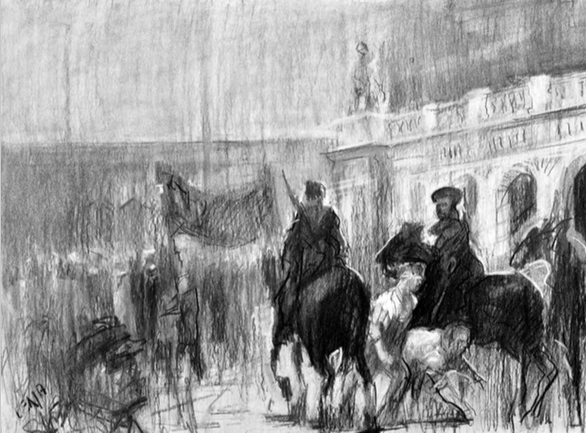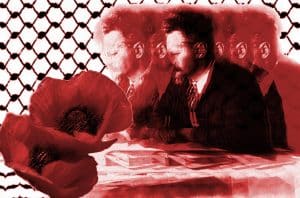One hundred years later, the Russian Revolution has remained lodged in the throat of official story-tellers, histories and calendars, that have failed to metabolize the Bolshevik experience. No neutrality is possible. To celebrate it, to condemn it, or to ignore it is a political act in itself. In Vladimir Putin’s Russia, no official commemoration took place this year. According to Putin’s narrative, there is room for nostalgia over Russia’s czarist or Stalinist periods but not for a defense of the first victorious workers’ revolution of the 20th century.
Capitalism’s propagandists have taken the opportunity offered by the centennial to rehash tired rhetoric about “totalitarianism.” An army of academics, historians, and experts persist in their efforts to delegitimize the Russian Revolution, attempting to undermine the very idea of a social revolution.
Although this narrative is losing the hypnotic appeal it held right after the Cold War, conventional wisdom, which associates the Russian Revolution with the Stalinist gulags, still seems to limit the imagination of the political currents emerging to the left of traditional reformism. In the current context of a prolonged crisis of capitalism and its parties, as well as the emergence of new political phenomena, the question is raised once again: Shall we recreate illusions in reformism or prepare for the next revolution?
Coup or Revolution?
During the Cold War, the capitalist bloc led by the United States spread the idea that the Russian Revolution was a “coup,” a conspiratorial action of the Bolshevik minority led by Lenin. They claimed the Bolsheviks had expropriated the “good revolution” of February 1917 – that is, they had destroyed the nascent bourgeois democracy and put the country on an inevitable path towards totalitarianism. Some even went so far as to argue that the seizure of power had interrupted a process of self-reform by the czarist autocracy. In short, they say that Russia’s democratic future was transformed into a dictatorship by the October Revolution.
This interpretation has always lacked scientific rigor, regardless of its historiographic pretensions. The narrative of a “democratic Russia” was a partisan – and indeed quite crude – ideological operation. Had the counter-revolution triumphed, no democracy would have been possible. In fact, the very basis of the revolution was the fact that the liberal bourgeoisie had proven itself incapable of fulfilling the democratic demands of the people such as granting land to the peasantry. That demand, together with one to end the war, had been the driving force behind the February Revolution and ultimately set the dynamic of the October Revolution in motion. As the Bolsheviks asserted (even when they considered the revolution to have a bourgeois-democratic character), only the power of the working class in alliance with the poor peasantry could carry out these democratic tasks.
The other act of intellectual dishonesty was to make the revolution disappear, claiming that the seizure of power hadn’t been an act of the masses but rather of a bloodthirsty minority headed by Lenin.
The comparison between revolution and putsch was debated extensively in the years after the seizure of power, not only by liberals but also by social-democratic reformists who believed that the Russian Revolution had been premature. They repudiated the dictatorship of the proletariat, to which they counterposed democracy (1).
In his History of the Russian Revolution, Leon Trotsky reflects on the specific difference between conspiracy and revolution. He maintains that revolutions and insurrections cannot be artificially generated, while coups, by definition, are planned behind the backs of the masses and are carried out by a minority. Above all, they have different results: putsches settle power struggles among cliques of the ruling class, but the emergence of a new social regime, that is the rule of another class (or alliance of classes), can only be the product of a mass insurrection. Trotsky referred to insurrection not as an explosive act of social forces (which occurred frequently during this period) but as a complex “art,” with a leadership and a plan. It had elements of conspiracy as well, but these were of a technical and subordinate nature (2).
Throughout the years, various historians have acknowledged this specific difference between a coup and a revolution. An entire volume of Edward H. Carr’s classic work on the Russian Revolution is dedicated to the self-organization of the masses during 1917 and in the first phase of the Soviet government (3).
Liberalism, Stalinism and Totalitarianism
The definition of Stalinism as a totalitarian regime and the comparison of Stalinism to Nazism was not an invention of the Cold War. Many years earlier, Trotsky had used the metaphor of “twin stars” to compare Hitler and Stalin, but he pointed out the fundamental distinction between the two phenomena: the monstrous Stalinist dictatorship differed from that of Hitler because the former was still based on the control over the means of production established by the October Revolution (4).
Although the Stalinization of the Soviet Union certainly enabled capitalist propaganda to gain footing, the description of the revolution as a coup, just like the supposedly unavoidable link between communism and totalitarianism, was called into question by liberal intellectuals at an early stage.
Perhaps the most notable of these theorists was Hannah Arendt. Arendt who, at the start of the Cold War, still believed in American “democracy,” (an idea with which she eventually became disillusioned) developed a theory of totalitarianism in the Soviet Union (and in Nazi Germany). Among her important insights about the totalitarian phenomenon was the understanding that the pulverization of the classes and their transformation into masses of atomized individuals was a condition for the triumph of totalitarianism.5 She also recognized the formation of soviets as representative of a universal tendency in all revolutions: that of mass actions that aim to establish a new constituent power (6). This does not mean that Arendt was a partisan of the Russian Revolution (which she compared to the French Revolution because both were contaminated by the “social question”). According to her conception of politics, there was an irresolvable contradiction between liberation from necessity, i.e. the social question, and freedom which was exclusively political (7).
Neoliberalism Reloaded in Times of Organic Crisis
After the fall of the Berlin Wall, the equivalency between revolution and totalitarianism became generalized as “common sense,” spreading beyond right wing and liberal historians into left-wing currents. Left groups, especially those into different variations of autonomism reject the perspective of seizing state power because they consider this to be the fundamental reason for bureaucratization.
Without any new insights, this right-wing common sense has forcefully returned, on the centennial of the Russian Revolution, in a book by Tony Brenton, former British ambassador to Moscow. It includes articles by renowned reactionaries like Orlando Figes and Richard Pipes, a former security advisor to President Ronald Reagan. Suggestively titled Was Revolution Inevitable? Turning Points of the Russian Revolution, it uses a method of counterfactual history to demonstrate that the Russian Revolution was a mere accident (8).
Sheila Fitzpatrick, among the most prominent of the U.S. and English revisionist historians that emerged from the wave of radicalization in the 1960s and 1970s, points out the significant methodological weaknesses of this narrative. Besides the questionable validity of the historical facts, the logic is based on a completely arbitrary use of contingency and historical necessity.9 According to Brenton’s book, Stalinism is a historical necessity– an inevitable outcome of the October Revolution. On the other hand, Brenton says that the revolution itself is a mere accident; it cannot be explained by the previous objective and subjective conditions (the war, the desperate situation of the peasants, and czarist oppression, to name the most obvious). It would be foolish to deny contingency in history. But even accidents, particularly those that lead to changes of historical magnitude, do not occur in a vacuum. Nor do the political and social forces that are able to capitalize on them fall from the sky.
This faulty analysis may now be reaching its own limits. A quarter of a century after the dissolution of the Soviet Union, there are clear indications that this narrative is losing its appeal, especially for new generations who, for the first time since World War II, understand that they will have a standard of living that is worse than that of their parents. Their lived experience is not Stalinism but the capitalist crisis, Trump’s Bonapartism, imperialist wars, and the re-emergence of reactionary nationalisms and the proto-fascist right. Even Brenton cannot avoid having to account for the capitalist crisis of 2008 and the decline of liberal democracy. Despite his calming tone, he recognizes that the Great Recession put Karl Marx on France’s non-fiction bestseller list.
This concern is crudely expressed by Douglas Murray in National Review, who laments that “the virus of Communism — in every Marxist, socialist strain — remains alive and well” and that “it has become acceptable on the political left, including the parliamentary left, to open the whole socialist possibility up again.”(10)
The crisis of 2008 has opened tendencies towards organic crisis in the central countries, and aberrant phenomena have emerged along with new ways of thinking. This explains both the massive influx of young people into the British Labour Party under the leadership of Jeremy Corbyn and the more than 13 million Americans, mostly under 30, who voted for Bernie Sanders, a self-proclaimed democratic socialist. The Democratic Socialists of America (DSA), who have organized within this movement, have experienced meteoric growth in the months since Trump’s inauguration, reaching 30 thousand members. In Argentina, the rise of the Left and Workers’ Front (FIT), although on a smaller scale, cannot be separated from these trends in the international situation. The FIT, however, distinguishes itself from these other phenomena in that it is a clearly anti-capitalist left formation that promotes the political independence of workers and the struggle for a workers’ government that breaks with capitalism.
This is not yet a moment of political radicalization, but the exhaustion of neoliberalism has provided an opening for a war of ideas and strategies.
The Russian Revolution in the Current Strategic Debate
In an op-ed on the Russian Revolution in The New York Times, Bhaskar Sunkara, editor of Jacobin, summarizes the argument made by the left groups that emerged after the collapse of the old social democratic parties (11).
According to Sunkara, we should reject the caricature of Lenin and the Bolsheviks as “crazed demons” and see them as “well-intentioned people trying to build a better world.” At the same time, he says, we must try to “avoid their failures” which —and this implication is clear despite the somewhat ambiguous language he uses — led from the revolution to Stalinism. Sunkara’s proposal is to return to social democracy: “not the social democracy of François Hollande… but that of the early days of the Second International. This social democracy would involve a commitment to a free civil society, especially for oppositional voices; the need for institutional checks and balances on power; and a vision of a transition to socialism that does not require a ‘year zero’ break with the present.” In line with this proposal, he maintains that “stripped down to its essence, and returned to its roots, socialism is an ideology of radical democracy.”(12) Since he does not specify the date to which he wishes to return, we can assume he has chosen the Second International prior to its betrayal in 1914 when the Social Democratic Party of Germany voted for war credits, capitulating to its own bourgeoisie. That betrayal, however, did not come like a bolt from a clear blue sky. Before 1914, social democracy had already begun to harbor right-wing opportunist tendencies, particularly within the trade unions, whose leadership had discovered that speaking about “socialism” and “revolution” jeopardized the privileges they had obtained within the bourgeois regime. Broad sectors even supported colonialism, believing it to be a civilizing mission (13).
The recent rise of Syriza, and its immediate capitulation to the Troika, demonstrates that the neo-reformist project of recycling social democracy’s strategies — those of class conciliation and gradually advancing within the limits of the bourgeois state — is doomed to failure.
The goal is not to mechanically repeat the Russian experience in the 21st century, but rather to value its legacy for the inevitable upcoming revolutions. Its fundamental lessons are universal and have stood the test of the previous century; there can be no peaceful transition toward a society free of exploitation without a “year zero” break from capitalism. This impossibility is due to the violence of the exploiters who, when their interests are threatened, don’t hesitate to resort to the most brutal repression which is then carried out by the state on their behalf. In these decisive moments in which the fate of the revolution is at stake, we need a party like that of Lenin (and not of Kautsky) in order to triumph, and such a party cannot be built on the eve of the revolution. The construction of this revolutionary and internationalist workers’ party is our central task today.
Translated by Marisela Trevin
1 This is the core of the polemic that Trotsky develops against Kautsky in Terrorism and Communism (1920).
2 Leon Trotsky, “The Art of Insurrection,” in The History of the Russian Revolution, vol. 2 (Buenos Aires: Ediciones IPS, 2017), 437-462.
3 Edward Hallett Carr, History of Soviet Russia, vol. 1, The Bolshevik Revolution, 1917-1923 (New York: W.W. Norton & Company, 1985).
4 For a more in-depth look at the process that led from bureaucratization to capitalist restoration in the Soviet Union and Eastern Europe, see: Claudia Cinatti, “La actualidad del análisis de Trotsky frente a las nuevas (y viejas) controversias sobre la transición al socialismo,” Revista Estrategia Internacional 22 (25 November 2005).
5 “To change Lenin’s revolutionary dictatorship into full totalitarian rule, Stalin had first to create artificially that atomized society which had been prepared for the Nazis in Germany by historical circumstances… In order to fabricate an atomized and structureless mass, he had first to liquidate the remnants of power in the Soviets which, as the chief organ of national representation, still played a certain role and prevented absolute rule by the party hierarchy.” Hannah Arendt, The Origins of Totalitarianism (Orlando: Houghton Mifflin Harcourt, 1973), 318-319.
6 Arendt’s work incorporates the form “council” (the Paris Commune, the soviets of the three Russian revolutions, the Räte of the German revolution, the councils of the Hungarian political revolution of 1956) in her liberal theory, comparing them to the system of districts proposed by Thomas Jefferson. She also argues that there is an insurmountable separation between “soviet” and “party”. But the sheer fact that she sees soviets as a “lost treasure” of revolutionary tradition demonstrates the power of mass self-determination bodies as the embryos of a new kind of state. See: Hannah Arendt, On Revolution (New York: Penguin Books, 2006).
7 For a critique of this contradiction between “freedom” and “liberation” by Arendt, see:Claudia Cinatti y Emilio Albamonte, “Más allá de la democracia liberal y el totalitarismo,” Revista Estrategia Internacional 21 (1 September 2004).
8 Tony Brenton, Was Revolution Inevitable?: Turning Points of the Russian Revolution (New York: Oxford University Press, 2017).
9 Sheila Fitzpatrick, “What’s Left?” London Review of Books 39, no. 7 (30 March 2017): 13-15.
10 Douglas Murray, “The Russian Revolution, 100 Years On: Its Enduring Allure and Menace,” National Review, October 30, 2017.
11 This is not only a political discussion. In recent years, historians in the Marxist tradition have developed new research on the history of the Russian Revolution, the Bolshevik Party, and the role of Lenin. Although not the topic of this article, it is important to discuss Lars Lih’s argument that Lenin’s “April Theses” did not signify a strategic turn but rather maintains continuity between Lenin and the “old Bolsheviks.” This calls into question Lenin and Trotsky’s vision of the conciliatory policy of Stalin-Kamenev towards the Provisional Government, which continued to participate in the war. On this subject, see: Lars T. Lih, “The Lies We Tell About Lenin,” Jacobin, July 23, 2014; “From February to October,” Jacobin, May 11, 2017.
12 Bhaskar Sunkara, “Socialism’s Future May Be Its Past,” The New York Times, June 26, 2017.
13 This position was raised by Eduard Bernstein but became a broad agreement among German social democrats to the point that it led to a major crisis at the Congress of Stuttgart in 1907.











